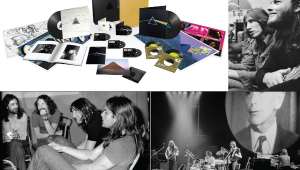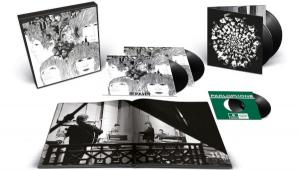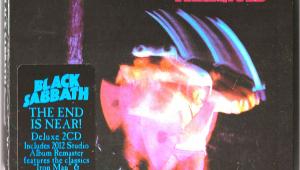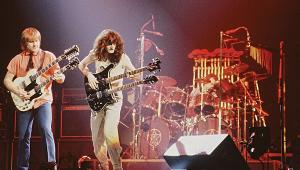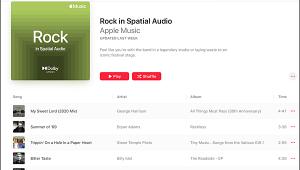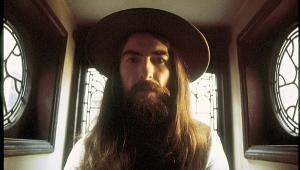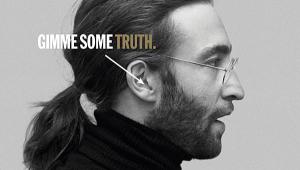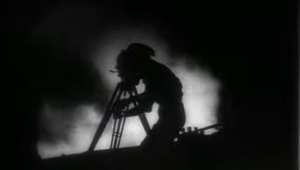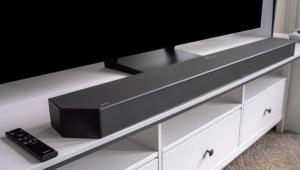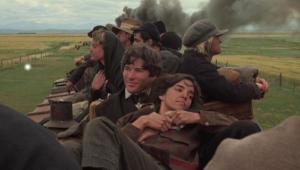There's a theory (one among so many regarding this band) that the colours red and blue were chosen because they are the home jersey colours of Liverpool's two main football (soccer) teams: Liverpool FC (red) and Everton (blue).
The Creation of The Beatles’ Last Song and the Rebirth of Red and Blue

How does the most popular band in rock music history both close out their recording history and celebrate their iconic legacy at the same time? Well, in early November, The Beatles accomplished both by releasing their last new recording, “Now and Then,” and reissuing their ever popular catalog compilation albums, The Beatles 1962-1966 and The Beatles 1967-1970—known informally as the “Red” and “Blue” albums (Apple/Capitol/UMe), augmented with dozens of new tracks and completely remixed in stereo. “Now and Then” was accompanied by both a 12-minute documentary about its creation, by filmmaker Oliver Murray, and a joyous, fun music video by director Peter Jackson.
The story of “Now and Then” goes back to 1977, when John was both enjoying his fairly new family life with Yoko and their new son, Sean, as well as continuing to write songs, many of which would end up on their 1980 last LP together, Double Fantasy (and its later follow-up, Milk and Honey). As was his custom—and in the manner of most songwriters—he would record a little songwriting demo for himself, just for future reference, likely on a boom box set atop or near his piano.
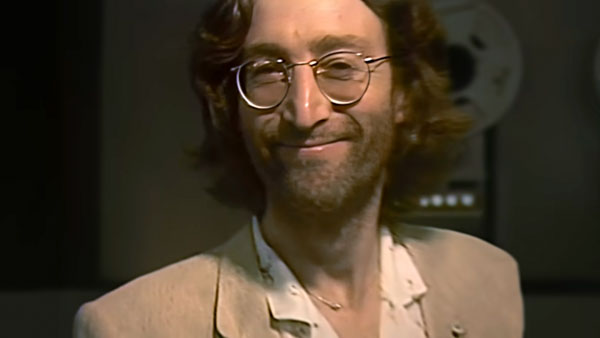
John, perhaps around the time of writing of “Now and Then” - © Apple Corps, Ltd.
Such was the case with “Now and Then”—or, as it was known then, “I Miss You” (according to engineer/arranger Marc Mann, an associate of producer Jeff Lynne’s, who prepped the recording for potential recording by the remaining Beatles in the mid-1990s, and handled the original cassette, with that title marked on it). Its title was also known as “I Don’t Want to Lose You,” as seen on a lyric sheet.
The boombox, BTW, has been mistakenly identified in numerous places on the internet as a Sony CF-580, based on a photograph that shows John at an upright piano, wearing a coat and tie, with Yoko watching at his side, with that recorder sitting atop the piano. While others have identified the photograph as having been taken at The Dakota, that is not actually the case.
Famed rock photographer Bob Gruen took the photo at The Hit Factory in September 1980, during the recording of Double Fantasy. “That’s actually in a room we had right off the control room, at the studio, where John liked to rehearse, relax or do yoga,” says Double Fantasy producer Jack Douglas. So was that recorder John’s, or did it belong to the studio? “It was mine,” says the producer.
A little more than 10 years later, in 1988, George Harrison was enjoying the success of his record made with some of his friends, The Traveling Wilburys, released on October 25 of that year to great acclaim from fans everywhere. Sadly, though, one of its five members, Roy Orbison, passed away less than two months later, on December 6.
According to Oliver Murray, who, in his research, heard George tell the story in a 1994 interview, of attending a party at Graceland not long after Roy’s death. Chatting with some of Elvis’s people there, George noted that Roy was irreplaceable, minimizing the likelihood of a future Wilburys recording project. During that conversation, he notes, it was commented that Elvis’s voice was the only comparable voice to Roy’s, and one of the Elvis team members noted the existence of tapes of the King with his voice isolated from the rest of the band/orchestra, suggesting Elvis could join the band.
“It started off as a throwaway conversation, but George and [Wilbury bandmate] Jeff Lynne took this idea seriously,” Murray notes. “After the party, they had conversations between themselves about the technology required to make a record with Elvis.”
The idea was still on his mind when George met up with Yoko in New York at the end of his trip, he notes. “When he told Yoko about the party at Graceland, and that the Elvis estate had tapes of his voice for a possible project, she said, ‘Oh, I’ve got a tape of John’s.’”
In January 1994, Paul brought that very idea up to Yoko himself, as well, asking if she indeed might have some recordings he and the others might be available for them to try to finish. Upon John’s induction into the Rock and Roll Hall of Fame, on January 19, Yoko indeed handed Paul a cassette with four such songs, copied from some of John’s original work cassettes: “Free As a Bird,” “Real Love,” “Grow Old With Me”—and “I Miss You” (“Now and Then”). [“Grow Old With Me” had been issued on Milk and Honey, and later, in 1998, on the Working Class Hero: The Definitive Collection compilation, with new string scoring by George Martin—coincidentally recorded by Steve Orchard, later Paul’s engineer at his Hog Hill Mill studio.]
Within a month, Paul assembled his former bandmates, George and Ringo, along with, at George’s suggestion, Lynne to co-produce, to record at Paul’s personal studio in Sussex, England, Hog Hill Mill (informally known simply as “The Mill”). “Jeff was so excited—he was giddy as a school boy,” recalls Marc Mann. “How he talked about that experience.”
Paul, who often still worked with former EMI/Beatles engineer Geoff Emerick, invited him to engineer the sessions. Emerick, in turn, asked his former assistant on a number of 1980s McCartney projects, Jon Jacobs—himself, by then an accomplished producer and engineer—to join him in engineering the recordings. “I hadn’t seen Geoff for years, and he called me right out of the blue,” Jacobs remembers. “He asked me, ‘Can you come and do it?’ and I said, ‘I’d be delighted!’”
.jpg)
Co-engineer Jon Jacobs at work in Paul’s studio, The Mill, in February 1995 - ©Apple Corps, Ltd.
It was decided that, of the four songs Yoko had provided, “Free As a Bird” would be recorded by the band. But before any recording could take place, John’s cassette recording had to be transferred to 2-inch, 24-track tape—and it was not a simple matter. A person sitting alone at a piano and recording himself singing a song, without a drummer or a metronome, but just as a work tape, does so at a naturally uneven tempo. So the song had to be put to tape, as the basis of the full recording, in a way that overcame that limitation.
“All we had was the cassette,” Jacobs states. “So what we did was, we chopped the whole recording into bits, recording each phrase of John’s recording into a sampler. We created a click track on the tape to have an even tempo as a base, and then, at the right point in time for each phrase, we would press the button and play that phrase onto the recording. It was done all by hand, one phrase at a time. So it was time consuming, and so fidgety. That was our learning curve.”
One other big issue they faced was the presence on John’s tape of his voice combined with his piano, from the simple monophonic recording. “If you wanted to raise John’s voice level at any point,” Jacobs explains, “it meant the piano would come up with it, and it would obliterate the rest of the instruments we were recording. And whenever John’s voice appeared, there was background noise,” hiss, etc., “depending on how loud he was playing the piano.” Paul, then, came up with a solution. “The only way to fix it was for Paul to double-track John’s lead vocal,” doing his best John imitation.
With the approaching release of the three The Beatles Anthology CD sets, the plan became to feature one new Beatles song on each set—“Free As a Bird” on Beatles Anthology 1, and two others for the second and third albums. Two other songs were selected from Yoko’s cassette—“Real Love” and “I Miss You” (henceforth, here, referred to as “Now and Then”). A new set of sessions would take place in February 1995 for the two additional songs. And once again, Jeff Lynne was asked to co-produce.
By this time, though, recording technology had begun to advance, so Jeff involved someone whom he had been working with for a few years, skilled with both arranging and programming, Marc Mann. Marc had also been working with composer Danny Elfman, and was always on top of new gear and new systems, something that could make working with John’s cassette recordings go much smoother.
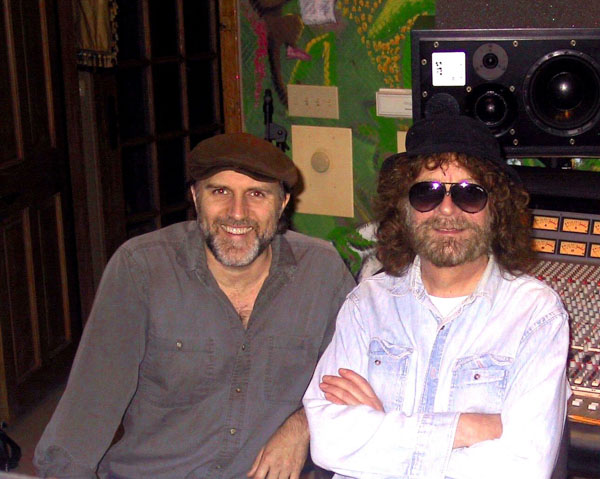
Arranger/programmer Marc Mann with producer Jeff Lynne - Courtesy Marc Mann
So in late December 1994/early January 1995, Marc got a call from Jeff. “He calls me on the phone, and doesn’t even tell me anything about it,” Marc recalls. “He goes, ‘Uh. . . y’busy?’ ‘Uh, why?’ ‘Can you come over?’” Jeff was living/working in a rented house, at the time, while his now-current home / studio was being completed. “I go over to the house, and he comes out and holds this cassette, and says, ‘Um. . We gotta do something with this.’” The producer proceeded to play the tape for him on a good quality TEAC double-cassette deck, which Marc owns to this day.
Both “Real Love” and “Now and Then” suffered from the same flaws on the tape, so Marc was put to work repairing them. The two musicians were, themselves, most fond of “Real Love,” which was the likely candidate for Beatles Anthology 2, so Marc’s repair time was spent on that tune, with, hopefully, time remaining to apply the same fixes to “Now and Then,” before Jeff had to fly to England to work on the sessions.
The main issues with the recordings were: hum, tape speed and low signal-to-noise ratio. There was a constant 60 Hz hum present on both songs. “That could be from a few different things,” he explains. “It’s a ground loop that happens sometimes in older buildings, like The Dakota, which means the recorder was plugged into an AC outlet. But it could also be from a nearby fluorescent light or other device which was on and near the recorder.”
The speed of the recording was a bit fast, owing to the fact that not every cassette recorder operated at correct speed. “Cassettes might be a format people don’t even think about anymore, but, at the time, cassettes were a very inexpensive, obvious format,” Marc notes. “And not every machine ran at the same speed.” Playing a cassette made on John’s boom box back on a TEAC cassette deck from nearly 20 years later isn’t going to sound the same, in fact, playing at a slightly higher pitch. The pitch issue, he notes, appeared on all four songs on the tape, indicating that each had likely been recorded on the very same machine originally.
“They’re also running at 1 7/8 inches per second, versus 15 or 30 ips on a studio tape machine, which means there’s a lower signal-to-noise ratio—more hiss.” Those elements, along with recording on a pair of cheap built-in microphones resulted in, for studio purposes, a pretty rough recording.
Again, working on “Real Love,” Marc first used the best cassette deck he could find, “to get the audio off the cassette and into the computer, so I was working in a digital format. And so that cassette wasn’t played more than once.” Though Pro Tools recording software had just appeared, at that time, it only had the ability to record four tracks, Marc notes. Instead, he recorded into Digidesign’s Sound Designer II.
Analogous to what Jon Jacobs described for “Free As a Bird,” Marc then broke each and every musical phrase—both John’s singing of lyrics (accompanied by his piano) and the piano segments between them—into dozens of individual files, each of which received its own treatment.
The main pieces of software Marc used included Digidesign Intelligent Noise Reduction (DINR, as it was known), Opcode Studio Vision (which allowed him to process both MIDI and audio tracks), Digidesign Sound Designer and Pro Tools.
Pitch correction, he notes, was also made worse by the fact that John’s piano was slightly out of tune. [He determined, later, that “Now and Then” was actually in A minor, though the tape played it in between B flat minor and A minor, the fix for which he indicated in his files as “-1 + 20”—down one step, and back up 20 cents (there’s 100 cents per half step in a scale.]
Once each phrase was corrected for noise and pitch, it was also time-stretched, where needed, to account for, again, the normal ebb and flow of tempo a person playing by himself will produce in his performance. A “rough mix” was then assembled, with each repaired phrase placed properly along a click track on the timeline, making a much cleaner read on “Real Love,” compared to the original cassette.
Jeff and Marc then created a mockup of the song, based in John’s recording, with Marc playing keyboards, Jeff playing bass, and both playing acoustic guitars, “Really, to convince Paul, George and Ringo that this was doable, and that it should be done.”
The prepped “Real Love” material was transferred to a 2” 24-track tape, which Jeff brought with him to England. The tape had Marc’s click track, John’s clean up and timed vocal, guide piano, guitars, bass and drums. A rough mix was made to a 1/2” tape, and to cassette, for Jeff to listen to on the plane (and easily share with the lads), Marc notes.
With the main focus being “Real Love,” nearly all of the prep time was spent getting the song to that point—leaving just one day for Marc to do whatever he could to “Now and Then.” He had, by that point, done the identical steps that he had done on “Real Love,” of breaking the musical phrases apart—vocal + piano and piano—and setting them on an even tempo. A DAT tape was prepared on a Panasonic DAT recorder, with the vocal + piano on one channel and the piano phrases on the other, with a lead-in of click track, just before the music begins. “But Jeff had to get on a plane the next day,” Marc states, leaving him no time to do any of the other complex, time-consuming steps detailed above. That would prove unfortunate.
1995 Recording
Upon his arrival on Wednesday, February 1, Jeff handed those materials and the original cassette to one of The Mill’s engineering assistants, Keith Smith or Eddie Klein, the latter an Abbey Road veteran who built studios for John and George, as well. “The first thing that would have happened would have been Eddie or Keith logging in the cassette, and then one of them copied the DAT over to 2-inch tape,” Jon Jacobs explains. “At the time,” he explains, “Paul didn’t have Pro Tools. It was still in its infancy. Paul had two beautiful Studer A800 2-inch, 24-track tape machines, and that’s how he made all his records.”
According to Steve Orchard, Paul’s current in-house engineer at The Mill, as appears on the track sheet for that day, Keith copied the timed vocal track (which still had the piano mixed with it) only of “Real Love” (and including the click track lead-in) to Track 5 of the 24-track tape, doing the same for “Now and Then” onto Track 3. Then, using the click track lead-ins of each as a tempo guide, he added new click tracks for each (onto Track 9 for “Real Love” and Track 14 for “Now and Then”).
.jpg)
.jpg)
Tape box and track sheet from the first day of work on “Now and Then,” from Feb. 1, 1995. John’s vocals from the two tracks which were expected to be worked on, “Now and Then” and “Real Love,” have been transferred from the materials provided by Jeff Lynne. Click tracks were added to each, and a Linn Drum Machine’s drum track sounds were placed, as were some additional live fills by Ringo.
The following day, Thursday, February 2, the team decided to begin tackling “Now and Then. The group used John’s arrangement of “Now and Then” as it stood, which Marc Mann notes, “Some of it, he hadn’t even finished the words. He was coming up with the words, interpolating. And you can still hear a hint of that in the new release, where they used some lines repeated, and he had had other words there.” But it did keep the unused “B” sections, following verses, which do not appear in the final version.
A second 2” reel of tape—Ampex 499, as had become the standard in studios by then, running at 30 ips—was created that day. The new reel was used as the master reel, with the reel from the day before (the “slave” reel, in recording parlance of the day) synced together via SMPTE timecode, allowing the two reels to play/record together, so that items from Reel 1 could be heard, as well as easily copied, as desired, onto the master reel.
Curiously, though Ringo is seen in footage in Peter Jackson’s music video—which was shot on this day by The Beatles Anthology director Geoff Wonfor—playing on his full 1989 Ludwig Silver Sparkle kit (built in 1989 and first used on the first All-Starr Band tour that year), completely miked, that is not what actually occurred during tracking.
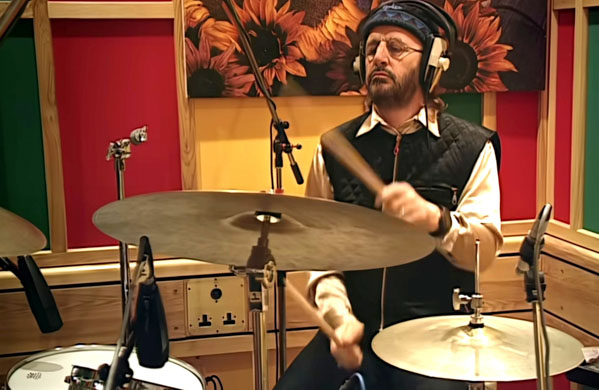 Ringo at his kit, rehearsing a drum part, during sessions at The Mill, February 1995 - © Apple Corps, Ltd.
Ringo at his kit, rehearsing a drum part, during sessions at The Mill, February 1995 - © Apple Corps, Ltd.
For “Now and Then,” he was not recorded in the manner Jeff Lynne normally prefers to record drums, as he would do for “Real Love.” For the latter’s recording, Jon Jacobs describes, “We didn’t record it as a drum kit, as such, but recorded the kick and the snare separately, due to the acoustics Jeff was after. For the snare, we moved it into the kitchen, so we could get an ambient sound, because the studio itself is kind of a dead area.” Ringo also performed some tom-tom fills in the barn.
And the unique Jeff Lynne snare sound, he explains, was recorded with a pair of U87 mics, about 8 feet away from the drum, to capture more room ambience. “I remember being quite blown away by the fact that we’d got a snare drum on the record, and there was no close miking involved at all,” as is customary when recording drums. It was these two mics and compression.” The compression was a favorite of Jeff’s, the classic Urei 1176. “That’s not simply his favorite—it’s his only limiter, I think!”
The drums captured for “Now and Then” were far different, Steve Orchard notes. For that song, a Linn Drum Machine, a popular electronic drum sequencer, was programmed to play the drum part (snare, kick drum and hi hat), likely played by Jeff himself. The output of the Linn machine was recorded onto Tracks 15, 16 and 17 of the slave reel, on February 1. Samples of Ringo hitting his snare, kick drum and hi hat were then recorded onto a DAT tape, and those were then recorded into an AMS Digital Delay and Sampler, Steve explains. Those samples, triggered by playback of the Linn drum machine sounds, were then recorded onto tracks on the master reel the following day. But on February 1, it was just the Linn sounds, with some additional cymbal and tom tom fills for “Now and Then,” along with tom and snare fills for “Real Love,” that Ringo recorded himself onto the slave reel.
On February 2, items from the slave reel were copied over to the master reel: the three Linn drum machine tracks (which were also used in place of a click track, for time keeping), John’s vocal, and Ringo’s tom and cymbal fills (the latter mixed together onto a single track). The Ringo drum samples, of his kick drum and snare, triggered by the Linn tracks, were then recorded onto Tracks 2 and 10, respectively, this day.
.jpg)
Track sheet from the Feb 2, 1995 “master reel” for “Now and Then,” written in engineering assistant Keith Smith’s own handwriting - © MPL Communications, Ltd. Used with permission.
Hi hat samples, recorded onto Track 3, appear to have gone unused, recorded over by Paul, recording is Wal bass, through a Boogie amp, onto that track (the Wal, with its additional lower 5th string, allowing Paul to compensate for the tuning/pitch issue).
Paul recorded a synth “pad,” played on an Oberheim B-X, onto Track 1. “That was a favorite of Jeff Lynne’s,” Steve describes. “The pad he played was a sound that’s hybrid of, say, a Fender Rhodes electric piano and a string sound, without much attack, kind of used to gell all the sounds together, like a glue.” The part, ultimately, was not used in the final, released mix.
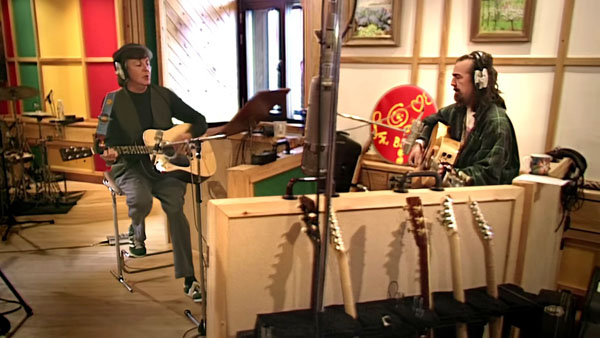 Paul and George record their acoustic guitar parts at Paul’s studio, The Mill, February 1995 - © Apple Corps, Ltd.
Paul and George record their acoustic guitar parts at Paul’s studio, The Mill, February 1995 - © Apple Corps, Ltd.
As seen in the music video footage, Paul and George first recorded a pair of acoustic guitars—Paul on a Martin D28, George playing his Gibson J-185—onto Tracks 19 and 20. [The two are using capos on the first frets of their guitars, to account for the fact that the speed and pitch of John’s vocal hadn’t yet been corrected by Marc Mann, as he had been able to do for “Real Love.”] Paul’s guitar was miked with a Neumann KM86, while George’s was captured with a Neumann U87. Each was recorded onto his own track.
George also recorded two separate tracks of electric guitar, onto tracks 12 and 16, both played on what is identified by Keith Smith on the track sheet as “Hamburg gtr,” through a “McLaren amp,” both George and amp sitting in the control room, recording the parts.
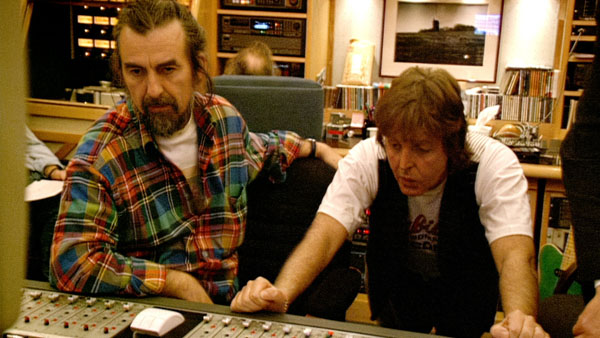
George and Paul listen to playback in the control room of The Mill, February 1995 - © Apple Corps, Ltd.
Paul replaced John’s piano with a new piano part, recorded in stereo onto Tracks 17 and 18 (though Marc notes the original idea was for John’s to remain, with Paul simply bolstering it with a new track). And Paul recorded his John-doubling vocal during this time onto Track 22, as he had done on “Free As a Bird.”
Ringo recorded some additional tom and snare fills, onto Tracks 7 and 8, and cymbal crashes onto Track 9. And Ringo and Paul, together, recorded onto Track 5, an assortment of shakers in Paul’s collection, identified by their color—Paul playing gold, yellow and pink egg shakers, while Ringo played what’s indicated as a “Bisodol”—an empty Bisodol bicarbonate of soda plastic container, filled with shaker sand. The two also played—again, together, onto a single track, Track 6, tambourines, Paul playing the studio’s black plastic tambo, with Ringo shaking both their green plastic one, as well as a red crescent-shaped one.
Even with all of this work as a start, it was soon, though, determined that the quality of John’s vocal for “Now and Then” left a lot to be desired, and they decided to abandon the song in favor of “Real Love.” “’Now and Then’ was the first thing we looked at,” Jon Jacobs recalls. “But we probably only played around with it for a day, maybe two days. We might have had a go at it, but we didn’t spend long on it. We started it, and then quickly moved on to ‘Real Love.’” Steve Orchard notes that the earliest date indicated on a “Real Love” master reel tape box was the following Friday, February 10. Given Jon’s recollection of jumping in on “Real Love” immediately upon giving up on “Now and Then” after a day or two’s work leaves what happened over the following week’s gap still a mystery—whether there was additional work done or that the group took a week’s break before beginning “Real Love” on the 10th.
.jpg)
Tape box label for the first true day of band work on “Now and Then,” Feb. 2, 1995 - © MPL Communications, Ltd. Used with permission.
George was especially vocal about not wanting to continue work on “Now and Then,” due to the audio quality issues. “It’s so regrettable that we didn’t get to complete the prep work on it”—noise reduction, hiss removal and cleanup—“before it was presented, as we were able to do for ‘Real Love,’” Marc Mann says. “It was presented prematurely, and George’s reaction to it may have been better had we had a chance to do that.”
The following year, though, in April 1996, Jeff was notified that, in preparation for the release of Beatles Anthology 3 later that year, the Fabs wanted to go ahead and give “Now and Then” another try. So he was asked to prep the song properly, as he and Marc had done the year before with “Real Love.”
Like the previous two tracks, the song was a ballad, not a rock and roll song, “So the challenge was to make this ballad into a Beatles ballad,” Marc states. Marc had considered the track a “later Lennon” song, longer form with more sonic changes. “It was an intimate piano performance, not just his intimate vocal. So the goal was to preserve that, as well as his voice.”
Jeff, by this time, had moved into his new house, with a fully-operational studio. “Jeff was open to me exploring different approaches and presenting ideas,” including an orchestral arrangement, with different arrangement choices to help delineate the different sections of the song, keeping intact John’s original song sections So Marc dove in, working his tedious restoration process all month, the same as he had done with “Real Love,” again breaking the song into vocal and piano phrases and working his magic on each, after which, he and Jeff would once again prepare a mockup to present to The Beatles.
“Then, around the end of the month or beginning of May, Jeff came in and just said, ‘Paul just called. We’re not doing it.’” Even without having heard the new work Jeff and Marc were busy creating, the band decided to just drop the whole idea—again, thinking it was not in a usable condition to make a recording. “We had done all this work, but because of having presented it too soon the previous February, prematurely, the opinion was that it wasn’t worth working on, which is a shame. It would have been a perfect fit on Beatles Anthology 3. I really think it matched his progression as a writer, and maturity as a father and as a human being. It gets down to the essence of what John was doing, reflecting about what really mattered, that you can miss these important people in your lives, something that really makes people think about what it means to be human.”
A Second Life
The recording was never far from mind for Paul. It was always something he knew he wanted to complete, but until much later, the technology simply wasn’t there to do it.
Engineer Steve Orchard, who’d started in the tape era in 1986, and had known Jon Jacobs since both their days at AIR Studios in London, first worked with Paul on orchestral sessions for his 2007 album, Memory Almost Full, as well as some tracking and mixing sessions at The Mill. Keith Smith and Eddie Klein had both been at the studio for a number of years, but were skilled mostly in analog recording. “Once things started to move more into Pro Tools and the computer, everything became a bit more technically challenging for them,” he notes. “So as things got more complex, I was getting called more and more to come over and help out. So Paul asked me to come onboard full time,” in about 2013.
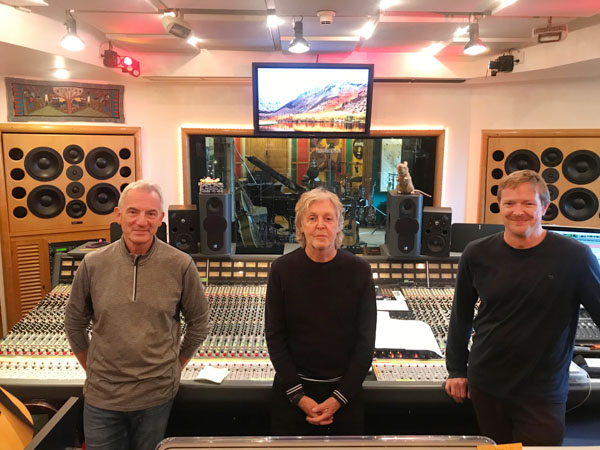
Longtime staff engineers at Paul’s studio, Hog Hill Mill, Keith Smith (left) and Steve Orchard (right) with Paul - MPL Communications, Inc.
Over the years, Paul would ask Steve to pull the “Now and Then” tape/hard drive “out of the cupboard” to refresh his thoughts about the recording. “We didn’t really do anything conclusive. It was just kind of going through, exploring the arrangement, things like that. Just getting a feel for it, really, and getting back in tune with the session, into that head space.” The two would work on the recording sporadically, in between different projects. “We’d dip into it for a bit, and then go on to other things.”
Eventually, in February 2021, Paul decided to take working on the song seriously. “We had finished McCartney III, which came out the previous December—which, you might recall, was recorded in what Paul called ‘Rockdown,’” during Covid lockdown, when he was unable to tour.
The tape, at that time, still contained the original vocal transfer from Marc Mann’s DAT tape from 1995, which had none of Marc restoration work, done the following year. “The 60 Hz hum was atrocious,” Orchard notes. “The whole thing just sounded really ropey. You could understand why it was left where it was, at that time.”
It still had Paul and George’s acoustic guitars, George’s electric rhythm guitar, Paul’s bass, piano and vocal, the Linn Drum tracks, the drum sample parts and Ringo’s fills—and, of course, John’s original piano from Marc’s DAT.
“The piano was just so mushy, it was just not usable. And the vocal—although they tried to clean it up with what they had at the time in 1995, it just wasn’t really great. We tried some things, like Rx Isotope, which has a great music rebalance tool, to try and clean it up. It was slightly better, but it was still mushy and distorted, and didn’t sound good. Certainly not anywhere near what we ended up with.”
Another concern was speed correction—which meant pitch correction—since Marc Mann hadn’t had the opportunity to address before the DAT was sent over, though the issue wasn’t considered in that way when Paul began working on it again. “Paul was figuring out the chords and working through the arrangement. And he was thinking, ‘It doesn’t quite sit right, the shapes of the chords.’ He said it was one step too high in pitch. He was saying that the chord shapes were not something John would have written in.” As you’ll recall, both Paul and George are seen playing their acoustic guitars with capos in the 1995 session footage, to account for the pitch difference from the norm.
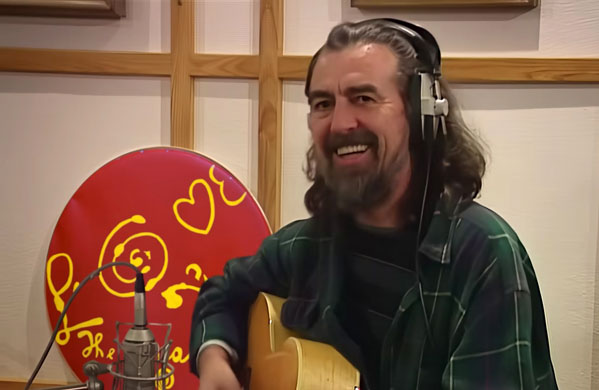
George tracking his acoustic guitar part for “Now and Then” at The Mill, February 1995 - © Apple Corps, Ltd.
On Monday, February 1, as work began in earnest—26 years to the day that work had first begun on the song—Paul and his engineer used Waves Soundshifter to lower the pitch down 1/2 a step.. “Once that happened, and he transposed it all down a semi-tone, it locked right in and felt right. It changed the whole feel of everything, really.”
On that day, the two also made a significant change to the arrangement. Paul decided to cut out the “B” sections within the song (which can be heard on bootlegs of the original recording). “It was a cool section, but it wasn’t resonating with him,” Orchard recalls. “He was saying that John was almost fishing for chords there. It wasn’t quite nailed and solid. And he said that, back in the day, when they were writing together, if there was a section in the song that Paul had written that John didn’t like, or vice versa, they would take it out. He wasn’t feeling like John would have been completely happy with how it was, and Paul wasn’t. Paul’s got such a great intuition, and knowing what it’s all about, what the feel is, how it should be.” And there truly is only one person on earth who any of us can trust to make such a decision, who would know what songwriting with John Lennon was truly like.
The following day, on February 2, Paul decided, in George’s absence and in his honor, to add a slide guitar solo. The solo was played in a section of the song John apparently had written/left for such a solo, Orchard notes. “It was part of what was already there. We didn’t take anything out or add anything.”
The solo was played on a vintage 1960s (or earlier) Rickenbacker lap steel guitar. “He’s had it for years—I think Linda had gotten it for him. It’s beautiful.” The guitar was played through Paul’s vintage Vox AC30 guitar amp. “Then, we gave it a bunch of treatments, as well,” the engineer explains. “We put it through a Leslie cabinet. We amped it through some pedals, as well. There are all of these things layered up behind it, to give it tone. And then we also re-amped it around that time, too, playing it through a Marshall amp, with some pedals, just to get a bit more of a tone to it. Just behind the main sound, to reinforce it.” The two also used a Binson Echorec, a vintage magnetic drum delay device on the part, giving it a really cool sound.
The fact that this part would have normally been played by George on a Beatles record was not lost on Paul. “He was very mindful of that, making sure it had the right feel. He wanted it to be a fitting tribute to George.”
Paul also added a Baldwin electric harpsichord—the very one used on “Because” in 1969 on Abbey Road, which Paul obtained from the studio, at some point. “And we ran that through a Leslie cabinet, as well, just to get a nice cool effect.”
A few months passed before Paul returned to the recording. On Friday, July 9, Paul replaced his original bass track, this time using his classic Hofner. “On the 1995 recording, he had used his Wal bass, which is a 5-string, I think because of that key business, due to the tape speed, just to get the extra notes in there. But once we’d transposed it, he didn’t need to do that anymore. So we used the Hofner on the main bass track,” recording three different passes, from which Steve created a comp track. Paul later changed a few bars here and there, when other parts would arrive back (strings, drums), he says.
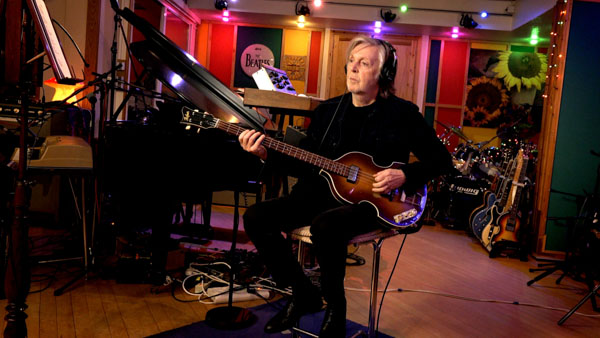
Paul recreating adding his bass line at The Mill, for the cameras of documentary director Oliver Murray, May 19, 2023 - © Apple Corps, Ltd.
Even after 10 years of working with McCartney, Steve still finds himself awestruck by his boss’s bass playing. “It’s just melodic. The number of times he’ll come out with something, and I’ll just think, ‘Where did that come from? What was that? That was amazing!’”
Paul’s similar skill level and decades of experience crafting perfect background vocal parts were put to work a few days later, on Monday, July 12, when he added his harmony vocal (to John’s main vocal) and double-tracked vocals in the choruses, the latter to simply reinforce. “The way he works out harmonies—he’ll listen to the part, figure it out, sometimes go to the keyboard and work out exactly what the notes are. He’s so great with harmonies. It’s in his DNA.”
McCartney’s excitement creating anything in the studio remains as passionate as ever. “It’s always surprising, the things he comes up with. It’s just amazing. He doesn’t fall into complacency at all. Even if we’re recording a percussion part, I’ll look out into the studio, and he’s really getting into it and performing it, even with the billionth shaker part he’s recording. You get a performance, and it comes through in the recording. It’s quite amazing—and quite inspiring, really.”
Paul’s count-in, heard at the beginning of the song is from the original 1995 session. The talking at the end, Steve informs, is George, saying something slightly off mic. “It’s just part of the whole experience, them bringing all of their magic together. It just makes it more complete, more authentic, keeping those in. It’s something that happened, and Paul’s very keen on things like that, incidental things that aren’t what you’d expect. He just goes, ‘That’s cool. Let’s leave that in.’ He doesn’t want to clean things up to the point that it’s sterile.”
Even with all of the one-on-one work he’s done with Paul over the years, Steve knew this one was special. “There was a certain energy of what this is, just by virtue of what it is: a certain gravitas, just by virtue of who’s involved.” Hearing those two people singing together, as they used to do, decades before.
Enter MAL
As the end of 2021 rolled around, and Peter Jackson’s The Beatles: Get Back was completed and premiered, Paul was still not satisfied with the quality of the sound of John’s voice from the cassette—and unable to separate it from the piano. He found himself quite impressed with Jackson’s Park Road Post Productions team’s ability to use an in-house-designed Machine Assisted Learning system—nicknamed “MAL”—to separate Beatle dialogue from musical instruments playing in the background for the film. So in early February 2022, he asked the company’s Head of Machine Learning, Emile de la Rey, to see if he could do anything to improve John’s vocal using the system.
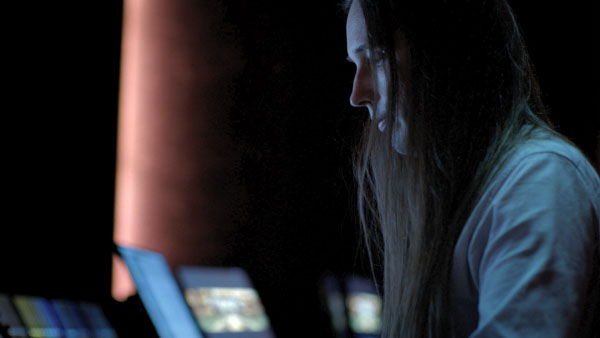
Park Road Post’s machine learning wizard, Emile de la Rey. Emile not only lead the team extracting and revitalizing John’s vocal for “Now and Then,” but also all of the Red and Blue album source separations - © Apple Corps, Ltd.
Emile had already begun improving the system for use separating instruments in single-channel rhythm tracks on 4-track session tapes for Revolver, for that album’s remixing project, which was underway. “At the heart of the process,” he explains, “lies a source separation neural network, to create intricate ‘stencils,’ which are used to mask out any undesired sounds, leaving behind just those sounds we’re targeting,” in this case, John’s vocal, separate from the tape noise and piano. While other system are available commercially, MAL produces much higher quality results than any other.
And while AI Generators—a hot topic in 2023—were quickly confused with something that somehow created a faux John voice, Emile notes, “MAL’s neural network architecture works more as a precise manipulator, rather than a generator. It makes specific targeted adjustments,” essentially ‘painting out’ unwanted sounds. “It’s crucial to understand that these models don’t actually generate anything fundamentally new from the original audio.” In other words. . . that’s John’s voice we’re hearing—period. As Marc Mann notes, “There are glitches I recognize, from working with individual vocal phrases back in 1996—the way he said ‘It’s true’ and left off the ‘it,’ the way he phrased and swallowed some consonants. And those are still there. That’s all John.”
He received the initial digitization of the cassette Yoko had given Paul, as mentioned, in early February, which he described as “quite a challenge! The quality was far from ideal.” He first cleaned the noise from the recording, and then isolated John’s voice from the piano. “The initial results were the best I could achieve at the time, but the deteriorated tape quality meant the vocals lacked clarity and suffered from some distortion. I doubt how well that first version of the isolated vocals could blend into a modern mix.”
It was still a massive improvement, and was sent back to Paul on February 21 and inserted into the recording by Steve Orchard at The Mill, replacing the original transfer from 1995. “When we got John’s voice back from Emile, we put it up against Paul’s, and it just sounded fantastic,” Steve notes. “It just had that instant thing they have together. And just having the clarity there, it just made everything more focused, which permeated out to everything else that was done.”
Paul now had a good start on finishing the song, but wanted another producer’s input. “I think Paul did approach Jeff Lynne about this,” says co-producer Giles Martin, son of legendary Beatles producer Sir George Martin, and who has produced the remixed deluxe reissues of the later Beatles albums. “I just think he was such a collaborator with George Harrison, he probably just thought, ‘I’ve done that. I don’t want to go back.’ So they had to wind up with some dodgy choice,” he smiles.
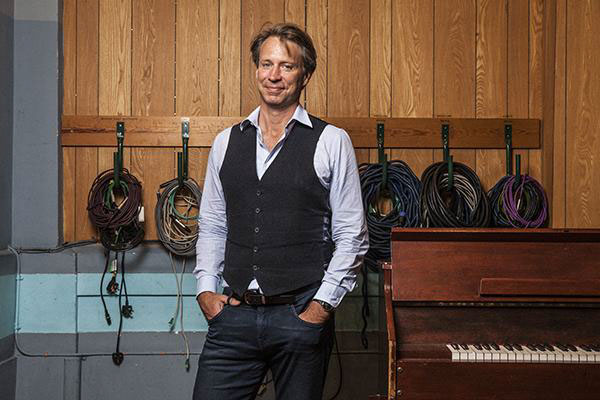
Co-producer Giles Martin - Photo by Alex Lake
An old friend of Steve Orchard’s, from their days when Steve was an assistant engineer at AIR Studios in 1988, Giles had heard from his pal that Paul had indeed been working on “Now and Then,” which, he admits, “I didn’t even know existed.” Giles and Steve had been working on the Dolby Atmos mix of Wings’ 1973 LP, Red Rose Speedway, and Giles had invited Paul to Abbey Road to come have a listen. So, on Monday, March 7, Paul dropped in, but he brought a surprise of his own.
“He played me the track and wanted to know what my thoughts were about it,” the producer notes. “I knew he was going to be play it to me, because of what Steve had told me, and I was worried about hearing it. But I was really touched by it. And he looked at me and said, ‘Well, you know. . . do you want to get involved?’ as well as, ‘And what do you think?’ I told him, ‘I think it should sound a bit more Beatles.’”
Paul, of course, wanted to know in what ways. “I’d spoken to Ringo,” regarding the drum sounds on the track from 1995—the Linn Drum Machine—“and I said, ‘Yeah, it doesn’t sound like Ringo’s playing on it. It doesn’t sound enough like Ringo. And maybe we should add some strings. And I’ll try and put some backing vocals on it.’ And he went, ‘Whoa! Easy. . . Let’s not try and be corny here, or try and force the issue, or try and be creepy.’ Then we just said to each other, ‘Let’s just try things. And if it’s crap, no one needs to know, or you can fire me.’ So we started working on it, sending stuff back and forth and collaborating.”
There were a few things the two decided to remove from the existing session. Firstly, there had been a synth “pad” added, at some point, playing a background rhythm, which, with the addition of true strings, was unnecessary. “Don’t forget,” he says, “this was done at a different time.”
Regarding Ringo’s drums and the Linn sounds, he says, “It’s just a very different approach. Jeff tends to make things much more precise. So it was a bit more chopped. I just thought, ‘For now, it’d be good just to have Ringo live and raw, and not programmed.”
So Giles sent Bruce Sugar, Ringo’s own in-house engineer at his Rockabella West studio, in his home in Beverly Hills, the complete Pro Tools session for the song, as it stood, onto which he recorded Ringo’s new drum part on Sunday, April 9. Ringo keeps his 1940 Leedy Ludwig kit, purchased for him from Donn Bennette by his drum tech, Jeff Chonis, in the mid-1990s, set up in the studio, with Sugar’s standing mic setup—Ringo is always ready to record. The two also recorded Ringo’s vocal, heard in the chorus, alongside Paul’s, that day.
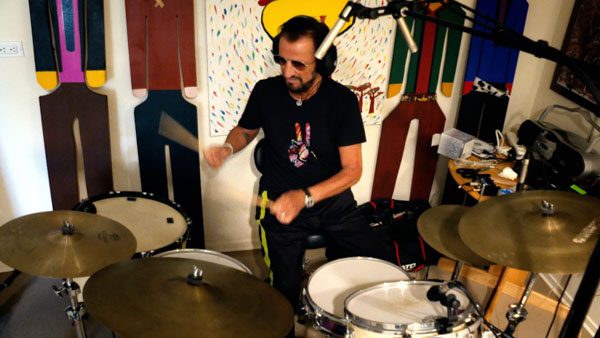
Ringo recording his new drum part for “Now and Then” at his home studio, Roccabella West, in Beverly Hills, on April 9, 2022, as photographed by his longtime videographer, Brent Carpenter - © Apple Corps, Ltd.
“We have it set up in there, we didn’t change anything,” says Bruce. “That original track from ’95 was stiff. It didn’t swing, like Ringo normally does. So he took the same approach he always has. He listened to the song a few times, to assimilate it, and then put down what he thought was the best track,” taking two or three passes, as he normally does, from which Sugar created a comp track. “Typically, it’s his first take that we use. His instincts are so great. He knows what Paul’s gonna do. He played it, and I sent it on to Giles. I offered to tweak anything Giles needed, but they went with what we had. And that’s what you hear.”
Capitol Studios staff engineer Steve Genewick was no stranger to Paul McCartney. A former assistant to both Geoff Emerick and highly-respected producer/engineer Al Schmitt, he was at the studio in September 1999, when Paul, Jeff Lynne and Emerick recorded “Maybe Baby” for a film soundtrack. He had tracked interviews with George in 2001, for his re-release of All Things Must Pass. And, in 2014, assisted Schmitt on his sessions with Paul for his Kisses on the Bottom album at Capitol, and later worked with Schmitt on the orchestral sessions for Paul’s Egypt Station. So when word came that he and his assistant, Chandler Harrod, would be recording strings for, as they were told, a Paul recording, produced by Giles, he was plenty excited. “We figured Paul’s got a song for a movie or something, who knows. A one-off song is not unusual,” the engineer recalls.
Giles and Paul would be coming in on Saturday, April 30, to prep for the string session the following day, on Sunday, May 1. “I talked to Giles on Friday, and he said, ‘Oh, I’ll drop a drive off for you guys with Security, on Friday night, before I go to dinner, and I’ll see you Saturday.’ On Saturday morning, Chandler had gotten there a few minutes before me, and he had grabbed the drive, which we put up, to prep the session.” When Steve walked in, Chandler had a remarkable look on his face. “He said, ‘You’re not gonna believe this. Just hit ‘Play.’ He had the vocal soloed, and I was, like, “’That’s not Paul.’ He started soloing stuff, and we quickly realized what we were working on.” Giles arrived not long after, to find the two smiling and laughing. “I told him, ‘Nobody told me we were doing a Beatles song!’ He said, ‘Yeah, we don’t let it get around that much.’” Then Paul came, and everybody in the control room knew what was happening. “He just said it was ‘one of the leftovers’ from the sessions when they did the Anthology,” Steve says.
.jpg)
Steve Genewick’s copy of the “Now and Then” score sheet. A false title, “Give and Take,” was indicated at the top of the musicians’ score sheets, to keep the project a secret. They were told the session was simply for a Paul McCartney project. - Courtesy Steve Genewick
He and Chandler spent that morning setting up mics for Sunday’s session in Studio A, the large studio, while Paul went through the arrangement in the control room with arranger Ben Foster, a colleague of Giles’s with whom he had worked many times before. “Ben had his laptop and had a mockup of the string arrangement, which they went through together. Paul would ask, ‘Oh, can you put that there?’—a run here or there, or a chord here or there that he wanted changed. Nothing major,” as he might have done with Giles’s father 50 years earlier.
.jpg)
Arranger Ben Foster conducts the string session for “Now and Then” at Capitol Studios, May 1, 2022 - © Apple Corps, Ltd.
“I played him the arrangement,” says Giles, “and one thing that was really important to him was George’s rhythm guitar part. He said, ‘Listen, George’s rhythm guitar is really important, and we need to make sure that we’re respecting that.’ And he was absolutely right,” prompting changes here or there to make sure it wasn’t obscured by any string phrasing.
The team was offered one other treat that day. “Giles was playing back the new Revolver mixes for Paul,” Steve remembers fondly. “We had the Pro Tools sessions, so we could solo the tracks and listen to it. And I have to say, listening to Revolver with Paul was quite a lot of fun.”
The day of the session, on Sunday, the players arrived as scheduled, Paul having gotten there even before they arrived. “As they started coming in, Paul was immediately out on the floor, chatting with them. And they were all happy to chat back,” Steve notes. The string section was fairly small—six violins, three violas, three celli and a bass, which Steve arranged and miked like a traditional orchestra, with violins towards the left, violas in the center, and the celli to the right, with the bass in the middle. [A footnote—Bruce Sugar just happened to be at the studio that day, as well. “I was actually in Studio C, mixing one of Ringo’s EPs,” his EP3, released that September.]
The players were told nothing more than that they were working a Paul McCartney session. “The score sheets actually had a different title on them—‘GIVE & TAKE’—with no artist listed,” Steve states, holding his copy of the score. “It just says, ‘Strings arranged by Paul McCartney, Giles Martin and Ben Foster.’” The players’ headphone mix had no vocals, which, Steve notes, is not unusual. “Nine times out of ten, they wouldn’t have the vocal anyway, because they don’t want to hear that while they’re playing. They just want to hear the rhythm section or the click track. I think they probably had the click, rhythm guitars, drums, bass and piano, and that’s it.”
Paul, he notes, spent much of the session in the studio, working with the musicians. “He was very positive, encouraging. Not a lot of notes given in the session. Perhaps he might have said, ‘Maybe can we try one where we get a little louder here?’ or ‘Can we back off on this chord a little bit here?’ There was no drama. Just a really simple session, when we got down to it.”
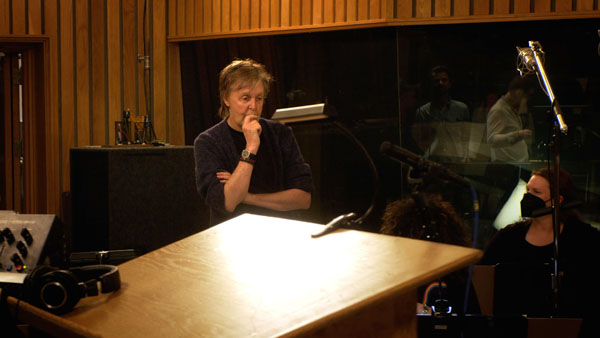
Paul listens to the musicians’ playing inside Capitol Studio A, during string session, May 1, 2022
- © Apple Corps, Ltd.
Though the players were told by the contractor not to take any pictures, Paul, of course, was fine. “He was out there, taking selfies with anyone who wanted one,” even posing for a group shot with the entire group of musicians. “Once the first one was taken, then everybody wanted one!”
After a few takes, Paul gave Steve some pretty special feedback. Remembering him, of course, from his Kisses on the Bottom session with Al Schmitt, he recalls, “After we had done a couple of takes, he came into the control room to listen. We hit ‘Play,’ and it sounded good. And then he just leaned over and whispered in my ear, ‘You were paying attention [to Schmitt]. It sounds great.’ Which was really cool for him to say.”
With all of the string sessions Steve has recorded, he notes, “That was certainly one of the most memorable string dates of my career. Any time you work with Paul it’s fantastic. But getting to work with him that closely was really fun.”
As Giles had promised Paul, following the string session, he did insert some background vocals, heard mostly during the song’s choruses. And as he had done before, for the creation of the Cirque du Soleil LOVE, Giles used background vocals from actual Beatles recordings—in this case, from “Here, There and Everywhere,” “Eleanor Rigby” and “Because.” “I have quite a good memory of keys and tempos,” he explains. “When I had brought it up to Paul initially, I said, ‘Let’s just try it. Cause it’s what you would have done, but they’re not around.’” And though Paul had already recorded some background vocal harmonies for those sections, the addition of the classic recording sounds made sense. “The sound of Paul singing background vocals is different from The Beatles singing background vocals. And part of that magic is the magic between them all, together.”
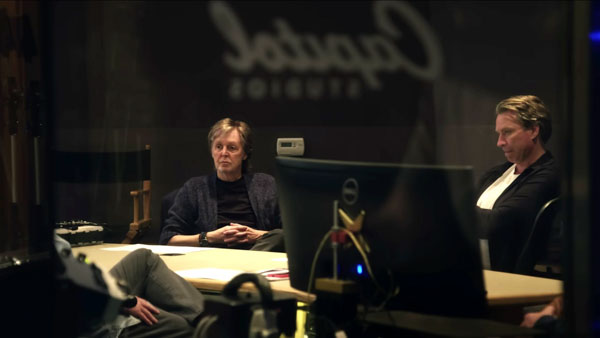
Paul and Giles Martin listen to playback in Capitol Studio A control room - © Apple Corps, Ltd.
Not long after, over a few days in June, the song was given its first—and, at the time, assumed, only—mix, by mixer Spike Stent (Ed Sheeran ,Harry Styles and The Foo Fighters), at Windmill Lane in Dublin Ireland. The experienced mixer and Giles are close friends, and the two have worked together for several years, but when Giles asked him to mix the track, Spike notes, “I had to pinch myself. I was just, ‘What??’” he laughs. “It’s probably the greatest honor of my 42 years working in recording, to have worked on a Beatles record that’s never been released before. The Beatles were always on, in a loop, at my dad’s house, when I was a boy. Abbey Road is still a very go-to record for me. So there was no question of whether I was going to do it or not.”
His goal was to make the track as authentic as possible, in ways that Beatles recordings always have. “The thing about The Beatles was, they touched us all. Not only emotionally ,but it felt like they’re always singing at you. The performance was something that surrounded you, and it took you on a journey. Emotionally, you were completely engaged. So I always kept that in mind.” While, he notes, it’s very easy to make records sound too slick, modern and bright today, keeping an eye on the journey the song takes us through was paramount, “while still making sure it's relatable to this day. An that’s quite a difficult balance. Things like Paul’s piano—should it be mono, should it be stereo? No, it should be mono-ish, and maybe somewhat lo fi, not too clean, grand or too big. It needed to be the journey of The Beatles, rather than just any record.”
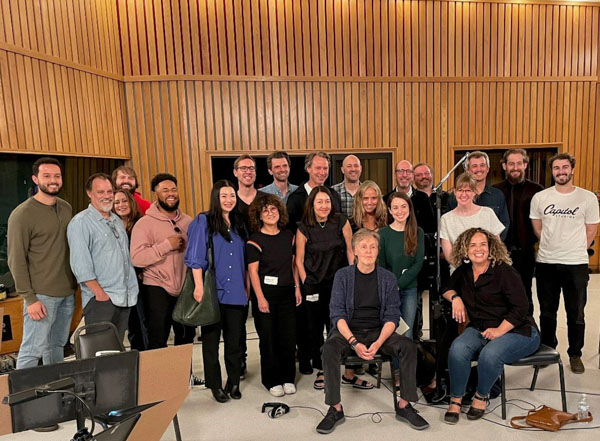
Paul happily poses with the string players after the May 1, 2022 string session for “Now and Then.” Engineer Steve Genewick is seen, second from left, while his assistant, Chandler Harrod is 3rd from right, back row - Photo by Gina Zimitti
Beatles records, too, never had parts fighting for prominence. George’s solos, like Paul’s here, always had their place. “Whenever there was a solo, it took front and center,” he explains. Ringo’s drum sounds, too, he notes, “were genius. His playing always left room for all the other instruments. He was very clever in that. So the tone of his snare and kick drum had to work with the rest of the music. By giving it that authentic sound, you knew it was Ringo. They needed to sound like they were of a certain period of time.”
To accomplish this, Spike made use of classic analog gear, such as old Neve compressor channel strips, Pye compressors, Pultecs on Ringo’s drums, and classic LA2A compressors on the vocals. “And I record the output of my outboard gear to pairs of stereo tracks, so I always have them available while mixing.”
Regarding his friend, Giles’s, work, “Giles’s strings are genius—the way they take off, emotionally. They’re really an important moment in the production and arrangement of the song.” And of the addition of true Beatles background vocals, mixed with Paul’s own, he says, “The background vocals in that section are brilliant. Suddenly, it goes into the stratosphere.”
And in case you’re trying to figure out who is who on the acoustic rhythm guitars, that’s Paul to the left, George to the right.
Spike’s first pass at a mix, of course, utilized Emile’s February MAL-repaired vocal, won which he took steps on his end to attempt further fixes. “At first, I was struggling, because it was still wasn’t quite there. “I was using the best technology that was available—I tried loads—trying to make it as legible as possible, but it wasn’t working. And then, when I got the vocal from New Zealand, it was like night and day.”
The original plan was to release “Now and Then” in October 2022, to celebrate the 60th anniversary of The Beatles’ first single, “Love Me Do,” together with their last. But still, the vocal wasn’t up to the quality Giles and Paul were looking for, so a new digitization of that cassette recording, still in Paul’s library, was made and sent to Emile in October for another pass. “This version had a fuller signal, but unfortunately had been heavily noise reduced, as well as edits made to the track itself,” he explains. “The edits were problematic, and I also prefer to get as close to an original source as possible when processing archival material with MAL Our own denoising models are able to yield a much better result than classical denoisers, which tend to leave behind noticeable spectral artfacting.”
So he and Peter Jackson met with Giles to discuss the tape situation. “Peter was convinced that there must still exist a true original master tape,” Emile states. “And then, a month or so later, Giles sent us the third version, ‘At last, I think we have it!’—a superb transfer of the original cassette, with no previous processing or editorial work done. I was able to successfully isolate a full and coherent vocal signal.”
Spike did a new mix with the new vocal in January 2023 at his own studio, SLS Studios UK, with one final pass coming on July 4th. “Having it properly clean meant we didn’t have to hide anything,” says Giles. “The first thing you’re drawn to on a record is the voice—it’s the first thing you recognize. It enabled us to make sure it was a John song and a Beatles song. I wanted to make su re it was Beatles, undiluted—that when you heard the track, you think, ‘Well, this is The Beatles.’ Cause it is The Beatles.”
The Red and The Blue
Since their release in April 1973, The Beatles 1962-1966 and The Beatles 1967-1970—commonly referred to as “The Red Album” and “The Blue Album,” due to their sleeve colors—have not only been the way many fans would enjoy their favorite tunes from the catalog, but have been the way many new fans found their way in to The Beatles. Even fans who owned few or none of the group’s original LPs owned these sets.
In late 2022, Apple was trying to find an appropriate album on which to place the new track, “Now and Then.” After the deluxe remixed Revolver was issued in late October that year, fans began hoping that Rubber Soul would be the next such release. “The question was, how do you celebrate ‘Now and Then?’” explains Giles Martin. “You can’t put that on Rubber Soul. And we’ve already reissued 1,” the top selling collection of No. 1 hits, originally released in 2000.
Apple and Universal, then, began thinking about creating a new compilation album, titled Now and Then, loosely based on a list of what the most popular Beatles songs were in the streaming world, as well as any other favorites the Apple Board (consisting of Paul, Ringo, Yoko/Sean and Olivia) might like to include. But after some discussion, it was decided to abandon that idea and go with a tried and true, existing compilation—the Red and Blue. And to make the reissue even more special, all of the tracks on the two sets would be remixed by Giles and his engineer, Sam Okell, with whom he had remixed the Beatles catalog albums (Revolver and later). The sets would also be augmented to include additional tracks, to reflect some of those songs now popular to fans via streaming, as well as others.
The albums’ history is an interesting one. While, today, we almost expect reissues and compilations to arrive from our favorite artists with some regularity, at the time, that was not the case with The Beatles. The last new Beatles album to arrive was Let It Be in 1970, and the bandmembers each already had a number of popular releases.
Historian Kevin Howlett, a member of the team who helps create the current lot of excellent Beatles reissue sets (and writes their liner notes), notes that ABKCO, the company owned by Allen Klein, who had signed on to manage Apple in 1969, may have been motivated by a film project. Apple’s longtime chief, Neil Aspinall, had been assembling a documentary about The Beatles, called The Long and Winding Road. “Some think it was nearing fruition, so perhaps the Red and Blue albums were designed to be the accompanying soundtrack. That’s one theory, but I don’t put much faith in that,” he says, adding that there is no existing paperwork in either Apple’s archives explaining the derivation of the albums.
More likely, he says, was that their creation was spurred by the presence of a bootleg collection of Beatles songs marketed on television, called Alpha Omega. Put together by a New Jersey-based company called Audiotape, Inc., Howlett notes, “The company played fast and loose with American copyright law. Prior to 1972, sound recordings were subject to state law, rather than federal law. And New Jersey had a loose interpretation of copyright. So they thought, ‘If we do a mail order set from New Jersey, we’ll get away with it.’ And it’s ludicrous to think they would have the right to do this.”
The set was released and marketed on television, selling for $13.95, and contained 60 songs over four LPs—curiously mostly placed in alphabetical order, with their audio sourced simply from Capitol Beatles LPs. So popular was the release that the company issued a second set a few months later. Each also contained popular Beatles solo tracks, as well. And, don’t forget, you could also order an 8-track tape set, if preferred.
Once Klein became aware of the album, in February 1973, he filed a lawsuit on behalf of Capitol Records, Apple Records, and, curiously, George Harrison, Howlett says. “The ABC network and its affiliates, who were running the commercials for this mail order box set quickly dropped the adverts, so they were removed from the lawsuit.”
The case was settled, but the album’s presence was proof to Klein that there was a demand for such a collection. Klein put his right hand man, Allen Steckler, to work, assembling the track list for what would become a pair of 2-disc albums, spanning The Beatles’ touring years (Red) and studio years (Blue).
Interestingly, Howlett notes, Steckler started the Red album’s running order with the UK single order—which was not how we got to know The Beatles here in the States, but which introduced The Beatles’ music in the order in which it originally came about. “It even includes ‘From Me To You,’ which hadn’t been available in the States since its release on a VeeJay Records single, and on an odd LP, in 1964, and was never on a Capitol LP,” Howlett points out. Steckler added other songs which were hit singles in the States, such as “Eight Days a Week” and “Yesterday,” as well as tracks from Rubber Soul—though, as Howlett notes, “He wasn’t thinking, ‘I’ve got six tracks from Rubber Soul.’ He was thinking, ‘I’ve got four tracks from Rubber Soul and two tracks from Yesterday. . . and Today,” one of the odd Capitol-produced American LPs, which pulled together singles and leftover songs from other albums Capitol had broken up to create their releases. And there were only two songs from Revolver, which were the two sides of its single.
Curiously, the American Red album also featured some different masters than the UK, indicating that, though the track lineup was set by Steckler in the U.S., the albums’ masters were assembled in both territories, separately. The American album, for instance, has some “fake stereo” (or, properly known, “Duophonic”) mixes, while the UK counterparts of those songs have true stereo mixes. And, quite specific to the U.S., the American master of “Help!” from 1965 Capitol LP, containing the James Bond theme at its start, appears on the U.S. Red album, but not in the British set.
The Blue album was more eclectic, with less singles to draw from during those years, thus more LP tracks. “There were four tracks from Pepper, two non-single tracks from the UK Magical Mystery Tour double EP set, and just three tracks from The White Album.” It was also the first time the single version of “Get Back” had been issued on LP, four years after its original release. “It was a generous amount of time per side on the Blue album, up to 26 minutes. They were really cramming the music onto that set.”
Its sleeve was designed by the great Tom Wilkes, known already for his designs for George’s All Things Must Pass, The Concert for Bangladesh, and his then-upcoming Living in the Material World. Its front and back covers consisted of outtake images from cover shoots for both their first LP, Please Please Me, from 1963, and the original design for their unused 1969 Get Back album, which recreated, in the exact poses, the look of the 1963 image, even shooting at the same location (EMI’s Manchester Square office building) and using the same photographer, Angus McBean.
The image used for the inner spread of the gatefold sleeve was taken in 1968, during what has come to be known as their “Mad Day Out” photo shoot, outside St. Pancras Church in London, on July 28, 1968, during a break from White Album sessions. The Beatles are seen mixed in with a crowd, all behind a fence with regular folk, with just one young boy in front of the fence. “It shows how inclusive The Beatles are. The Beatles were for everybody,” says Howlett. “They’re not saying, ‘Hey, we only hang out with hip looking people.’ They’re hidden in a crowd of people from all walks of life.” And the red and blue “color coding”—“That’s a stroke of genius. Those colors, for whatever reason, just seem appropriate to the two eras. And everyone began calling them the ‘Red’ and ‘Blue’ albums, all on their own, just the way everybody refers to their 1968 double-LP, The Beatles, as The White Album. The audience decided that is how they should be forever known.”
But it was the sheer power of the collections, one great song after another, that captured listeners. Even those who had always had the group’s regular LPs found themselves floored, hearing those key tracks in that order.
Kevin Howlett was 16 when the two albums came out. But he had had the good fortune of having an older brother who bought and played all of The Beatles’ catalog, when Kevin was much younger. “I was besotted from the word ‘Go,’” he says. But, when the Red and Blue arrived on April 2, 1973, “Many of my contemporaries were not as familiar with the music, as I was. People don’t usually get into pop music ‘til about 13, and The Beatles had split up by then. So, for many people, the Red and Blue were their gateway into The Beatles’ catalog. And I would often, at teenage parties, hear those albums being spun alongside Bowie and T Rex, and nobody thought, ‘Oh, that’s old music.’ It felt incredibly vibrant and contemporary.”
Surprisingly, Giles Martin himself, born in 1969, didn’t grow up hearing Beatles records spun constantly at home. “But I once went on a school ski trip, and a friend of mine had the Red and Blue on cassette,” he recalls. “And he’d play me the songs, especially early stuff. And I wasn’t aware of a lot of this material—and suddenly, I’m hearing it. And those early songs hooked me. So for a generation—which is my generation—the Red and Blue were our first Beatles albums.”
As mentioned, while the original sets had 26 and 28 tracks, respectively, the 2023 releases contain an additional 12 and 9 songs, respectively, above the original tune stacks. Says Giles, “As Beatles compilations go, a lot of the material on the original albums isn’t really reflective of what’s popular today, what people listen to most on streaming. Things like ‘Blackbird’ That’s not on any other compilation, but it’s a really popular Beatles track. I was in the car with my daughter today, in fact, and she was playing it.”
And there was a noticeable absence of George songs on the Red album, “which the expanded version readdresses,” Kevin notes. “Now we have ‘If I Needed Someone,’ ‘Roll Over Beethoven’ and ‘Taxman.’ It seems crazy that there were no George tracks on the original.” And there are even some cover versions and B-sides that have been added, like ‘You Can’t Do That,” the flip side of the original UK “Can’t Buy Me Love” single. “Anything on the B-side of a single in the UK is as well known as the A, cause you always played both sides.” And “Hey Bulldog,” which had been hidden away on the Yellow Submarine album, and later a single in Europe, “It’s now a part of the essential canon.”
Coming up with the extra tracks meant polling the Apple board and experts on the team, to get their input and choice selections. “Everybody made suggestions, and we eventually came up with a list,” says Kevin. “And I think it’s a pretty good list.” The challenge, of course, was what to leave off! “We all will still have all time favorites that didn’t make the cut in these 75 tracks. But that’s the strength of The Beatles’ catalog.”
Interestingly, the running orders on the CD and LP reissues, released on Friday November 10, 2023, differ. The CDs insert the added tracks in the correct chronological order, while the LPs leave the original running orders intact on the main two discs, adding a third disc for the added material (including “Now and Then,” which opens the third Blue LP). “The feeling was, if you’re buying the vinyl, to recreate the original experience of what those albums were like. It’s just a different approach,” explains Kevin.
Remixing with New Separation
It was during the Revolver project that Giles and Sam Okell, his engineer, got a sense of what was possible, utilizing Park Road Post’s MAL system for separating instruments which were originally recorded and mixed to a single track on a multitrack tape. “In early 2022,” recalls Emile de la Rey, “I established a workflow with Giles and Sam that was suitable for the evolving nature of MAL—which boiled down to providing them whatever separations I could manage to achieve!” In their initial meetings, “We settled on some fundamentals, what to prioritize,” including what individual drum kit components could be separated, once the drum kit itself was pulled out of the rhythm track.
.jpg)
Red and Blue remix engineer Sam Okell - Courtesy Sam Okell
He and his assistant took the time to map out every single instrument on each track of the multitrack tape (4-track tape, in this case), crossing them off, one by one, as he used the system to pull them out. “And as I encountered new types of instruments, I would train our foundational source separation models to deal with those instruments,” eventually picking apart the entire album’s recordings. Notes Sam, “Emile had done such good work on Get Back and the Revolver mixes, we now had a template for how to use this technology to make good remixes. We had a pretty good process.”
For the much larger number of tracks requiring separation for the Red and Blue albums (and mostly the Red, since the Blue generally consisted of mixes already recently created for the deluxe/anniversary editions of those source albums), Emile assembled a much larger team, who, once again, mapped out all of the existing instruments of each channel of each track. He then put the system to work. “We then tried to see just how far we could push the platform,” he informs.
“Ideally, you want everything separated out, to give you as much flexibility in the mix as possible,” explains Giles. “But there are limitations, depending on the compression on the original recordings, and how dense they are.” Rhythm tracks on Beatles recordings typically had, on a single track, drums, bass, rhythm guitar (sometimes two). “And Emile would often then further separate the drums into kick, snare, toms and cymbals,” says Sam. “So that’s seven elements coming out of one mono track.”
The application of that approach to recordings made in 1962 and 1963 are even more remarkable. Prior to October 1963, at the end of the recording of With The Beatles, when 4-track tape machines arrived, recordings at Abbey Road were made on what was referred to as “Twin-track.” Engineer Norman Smith would typically record the rhythm track instruments onto Track 1 of the tape, while the vocals—sung live—were placed on Track 2.
“The Twin-track recordings tend to have rhythm with vocal reverbs on Track 1,” Emile explains. “It was slightly tricky reaching a consistent vocal reverb isolation, parts of which tended to get lost to the cymbals. But we managed to get there. The full vocal signals on Track 2 tended to duck the other elements, such as guitars, quite heavily,” owing to the compression the strong vocal signals would initiate on the other track.
And if that’s not remarkable enough, there are two songs in the catalog for which no Twin-track master still exists—their very first single, “Love Me Do,” recorded in September 1962, and their fourth, “She Loves You,” recorded the following July. Without a Twin-track tape to mix from, those songs have never been released in true stereo—until now.
For drums, Giles explains, “When we started on Revolver, I said, ‘Emile, now you’ve given me a clean drum track. Can you now demix the demix? Can I now have kick drum, snare drum, toms, hi hat?’” But, as Emile notes, whether the initial format was mono, Twin-track or 4-track, the path to isolating the individual drum components tended to be consistently achievable, “with great isolation of the kick, snare, toms, cymbals and percussion elements,” and eventually, in late 2022, even isolating the hi hat from the cymbals, and the ride and crash cymbals from each other, which the system can now do. Absolutely remarkable.
An interesting thing with the vocals, which, as noted, in earlier recordings, were recorded live, with a Neumann U48 microphone set to its figure-eight pickup pattern, which allowed pickup from front and from back-facing sounds, but not sounds hitting the mic from its side. The Beatles would stand on either side of the mic and sing, with the mic placed so that its side faced the instruments in the room, thus reducing the amount of spill from those instruments that made it into the mic while they sang. And in later recordings, where the vocals were recorded as overdubs onto other tracks, a large playback speaker rig, affectionately known as the “White Elephant,” due to its size and color, was placed on that off-axis, to the singer’s right or left.
There was often spill, though, on the vocal track nonetheless, Sam says. “But Emile was finally able to separate the vocal from the band (or White Elephant) spill. So we had more control over it, which is fantastic.”
He adds, “It’s amazing, groundbreaking technology. Once you get the parts back, because the separations are so good, you can do almost anything you’d do if they were original multitrack splits. You very quickly stop thinking about the technology, and just go, ‘Okay, well, I’ve got this thing from 1963, and I just happen to have the drums separated into each element, I’ve got the bass, I’ve got all the rhythm guitars.’ It’s brilliant.”
Giles and Sam’s general approach to remixing Beatles has never changed since they began doing it with Sgt. Pepper’s Lonely Hearts Club Band—provide a fuller, richer mix, but remain respectful of the relationship fans have with the original mixes. “That’s really absolutely key,” Giles states. “The character and the tone of the song remains.” Sam agrees. “It has to be. And we’re constantly referencing the original mixes,” typically the mono, “and asking ourselves, ‘What have we done, and why have we done it? Is it better?’ It’s all subjective. The mixes are, once again, reviewed by the Apple Board. “We’ve had a few comments, and then subsequent revisions. It’s a collaborative process.”
“They are indeed respectful,” adds Kevin Howlett. “These mixes are listened to carefully by The Beatles themselves, and other people involved in the team. There’s so much love, care and attention that goes into the whole process.”
The mixes follow the same approach the two have taken for the later albums: drums, bass and lead vocals in the center, “Then,” says Sam, “we think about how do we make the band work around that?’” with guitars and other instruments spread to the sides, as appropriate. “We try to make it a slightly more modern stereo mix. And this brilliant technology has allowed us to do that with this early material.” Gone are the “ping pong” mixes, as Kevin Howlett calls them, of rhythm track hard left, vocals hard right. “Twist and Shout,” with John’s raucous vocal, Ringo’s drums and Paul’s bass now in the center, and the guitars to the sides, still sounds like a 1963 recording, just. . . better.
Kevin notes, “Giles always says, ‘I’m not doing this for you or me. It’s for a new generation. I’ll never make them sound like new recording; they’ll sound like Drake or Taylor Swift. But I want to make them sound like they’re the age they were when they were playing the songs. I want to make them vibrant, I want you to experience them as if you are hearing them playing in the room.’ And I think that’s what these mixes do.”
Drums are in the middle, explains Giles, because “No one wants to hear drums all on one side now. There’s a different approach now than there used to be in the Beatles’ days. Today, rhythm is everything. And drums coming out of two speakers, instead of just one, you get more power, more punch. There’s a huge benefit to hearing Ringo as you hear him now.”
Similarly, bass is in the center, instead of forced to one side. “Basses are interesting, because below 300 Hz, we don’t have much spatial recognition anyway, as human beings,” Giles says. “But on a track like ‘Drive My Car,’ the drums are panned slightly, because there’s simply not much on that track—only guitar and bass. A bass just panned to one side just doesn’t cut it.”
Once it had been decided upon to remix the two albums, at the end of 2022, Giles and Sam worked for almost a year remixing the nearly 50 songs required for the sets. “There was just so much material, doing both the stereo and Dolby Atmos mixes,” Sam says. The two would work both together and separately, in their own studios, getting together at Abbey Road here and there to finalize tracks together. “But we usually laid the groundwork separately.”
.jpg)
Sam Okell’s re-amping setup in Abbey Road Studio Two - Courtesy Sam Okell
The pair utilize something they’ve done for years now—re-amping. Speaker systems are set up in Abbey Road’s Studio Two, where most of The Beatles’ work took place, with a complex microphone rig placed many feet back, to capture the ambience of the room. “It’s quite laborious,” the engineer explains. “It’s a real time process. We play back every single drum split, every rhythm section, all vocals, all separately. We have a whole bunch of different mics, per signal, when we’re re-amping. So we end up with hundreds of tracks of this. And then, in the mix, we can decide what we want to use, what sounds best. It’s helpful in the stereo mixes, but certainly in the Atmos, where you might want to pan an instrument half left, and then pan the ambience of that to the right. It gives a bit more of a stereo width.” The process took about six days, total, for those countless ambience recordings.
Key Song Notes
Creating a stereo mix for “Love Me Do,” which has never had one, is something fans have hoped for for many years. Now they have one—and it’s quite good. And it is actually the first version of the recording, with Ringo drumming, which was briefly released in 1962. Its replacement, recorded a week later, with session drummer Andy White playing, with Ringo on tambourine, has forever since been the master. “The first version is actually the only Beatles master that was ever destroyed,” notes Kevin Howlett, all later copies of that recording ever issued were drawn from a 45 rpm single. “Now we have the original single version on the Red album, which is different from all previous issues of the set—and it’s in stereo, which is incredible.” And with Paul’s vocal now clear and in the center, separated from the other instruments, we get a true sense of his abilities as a blues singer.
The main challenge, when detangling a mono mix, explains Emile de la Rey, “The more sounds you pile on top of each other, the more potential dynamic interaction and masking there will be, especially when compression is involved.” Snare drum hits can cause the level of the guitars to “duck” down momentarily. “With a multitrack tape, there are less elements interacting with each other, so it’s a bit easier.” “Love Me Do,” thankfully, falls under the “simpler” category.
The group’s second single, recorded on Twin-track—and their first No. 1—“Please Please Me” is one in which Sam was able to take advantage of the full drum separations he had received from Emile. Ringo’s tom tom hits just before John’s “I don’t wanna sound complaining” bridge sections are heard rolling around the kit, as we might hear today—but just enough to bring it to life, but not turn it into something modern.
Songs taken from the group’s first LP, Please Please Me, also recorded on Twin-track, reveal elements maybe not noticed in the original ping-pong’d stereo, such as the handclaps now heard throughout “I Saw Her Standing There.”
For “From Me To You,” Sam took advantage of Emile’s skills by pulling John’s harmonica, heard in the intro in the original mono mix, but not in the stereo, and placing it in his new stereo mix. “Emile separated both the mono and the stereo, giving us the harmonica, and then we essentially recreated what they did in mono, but in stereo,” the engineer states.
One thing that often appears in Beatles rhythm tracks is both John and George playing electric guitars which are so similar in tone and power structure that even MAL has difficulty separating them. “That was definitely reaching the limits of what our models could achieve at the time,” Emile explains. “In the Twin-track recording on this song, George’s Gretsch was prominent on Track 1, and John’s Rickenbacker more audible in Track 2. However the level of John’s guitar part was very low, compared to the other elements. So the isolation of John’s guitar part that we were able to deliver to Giles didn’t work well, standing on its own in the mix.” So the two guitars are heard together.
“She Loves You,” the other of the two songs for which only a mono mix exists, proved a bit more difficult for MAL to separate out all of the elements, with so many parts piled on top of each other in a more raucous manner, including the constant swash of Ringo’s hi hat. “It has to do with the way the song is gelled together,” Giles explains. “’Love Me Do’ is slower, and it’s a less dense arrangement,” adds Sam. “So there’s more chance for the software to get hold of the separate elements. Here, everyone’s thrashing away.”
“That song was challenging, due to the qualities of the mono mix we were working from, especially around the interplay of vocal reverbs, cymbals and other high frequency elements,” Emile explains, “as well as a lot of dynamic masking happening between different elements, once separated. But it actually turned out to be on the best mono separations the MAL team had done up until that point, considering what we started with.”
The original master always had a noticeable edit between two sections of mix segments, audible at the 1:23 mark, before the “Pride can hurt you, too” line, where the mix suddenly becomes brighter, with louder cymbal crash. But Sam was able to finally smooth that out in his new mix. “I use a program called Cedar Retouch, which we’ve used a lot before, which has a clever function. You can look at the spectrum of the song’s wave, from low to high, with time and frequency, and it can do an interpolation between the two sections,” allowing him to unnoticeably adjust to a less bright mix in that second half.
A similar fix was applied to the tail end of “Roll Over Beethoven,” for an edit piece George had recorded for his final end chord, which always sounded like something that had been added. “It’s much easier to fix those types of things when you have a bit of separation between the instruments,” Sam points out.
An interesting thing the separations give him appears in their first U.S. smash hit, “I Want to Hold Your Hand,” again allowing him and Giles to handle elements that had been previously all piled together in a new way. A mystery instrument had always been heard throughout the song, playing a low-toned “do-do-do-do-do” alongside Paul’s bass, within the verses (e.g. after “I. . . tell ya somethin’”). “That’s actually a line being played by George on the low notes of his guitar, but not part of his lead guitar part. It’s actually on Track 4 of the 4-track tape,” on which engineer Norman Smith dropped a number of parts—that guitar line, handclaps, John’s double of “And when I touch you I feel happy,” and the high “hand!!” background vocals. It is a testament to George Martin, as a producer, to think to add parts such as this for emphasis, in what would be a raucous monophonic mix, and know the effect they would have on that mix.
While occasional session mistakes have an opportunity to be fixed in new mixes, sometimes Giles and Sam opt to leave them in, because they are simply how fans know the song. During the recording of the rhythm track in Paris in January 1964 for “Can’t Buy Me Love,” George played a lead guitar part which went unused—but the bleed from his guitar amp was picked up by Ringo’s drum mics, Sam reveals, something always heard in the background while listening to the guitar solo section, which George later replayed. “Giles and I actually talked about it. That’s part of the sound of the song, isn’t it.” While Emile likely could have removed it, “Taking it out would be wrong, wouldn’t it.” So it remains, as we’ve always known it.
Meanwhile, the bit of Ringo shuffling around at his kit heard during the opening bass note to “I Feel Fine,” clearly in the original stereo mix, is now gone. “We cleaned that one up a bit,” Sam notes.
While the string quartet for “Yesterday” was recorded together onto a single track, it is now heard in stereo. “The ‘Yesterday’ string separations were particularly magical!” a happy Emile notes. “At the same time Sam was asking whether a quartet separation might be possible, we had just started experimenting with models that could achieve such separations. It was a moment I’ll never forget, panning the quartet across the stereo space for the first time.”
The challenge, he notes was the fact that they were recorded using live playback of Paul’s vocal and guitar parts, via the handy White Elephant (headphones had not yet come into common use for recording overdubs at Abbey Road). “So we first had to lift away that guide track, and get the quartet sounding well isolated, before being able to even start disentangling the strings themselves,” he says. Notes Sam, “The extraction is so good—you can spread them out, as you would, across the image. It’s lovely.”
Of the Rubber Soul-era tracks, “Day Tripper” and “We Can Work It Out” are among Giles and Sam’s favorites, no longer suffering from the hard left, hard right panning. And the choice to bring the lead vocals out from hard right to center, with somewhat less reverb than the original mixes, allows one to hear the quality of the Fabs as the great singers that they were. And in the “Things we left intact” category, one can still hear one of the group reminding the others, during their background vocal overdub for “Girl,” to remember to sing “Tit-tit!”
“A Day In the Life” is presented with a clean opening—no crossfade with audience cheers from “Pepper (Reprise),” as it has always been heard. “That’s the mix from the 2017 release,” Sam informs. “We had mixed the track then with a clean start, and the applause segue was made during pre-mastering album assembly.”
One of the most challenging mixes of the whole set was “I Am the Walrus,” particularly for Emile and his team. As many fans know, the second half of the recording features a live radio broadcast of “King Lear,” which was added into the mix live, during the creation of the mono mix. With no way to replicate that addition for the stereo mix, Geoff Emerick instead passed the mono mix for that second half of the song through the studio’s Automatic Double-Tracking (ADT) system, essentially creating a “fake stereo” mix, for only the second half of the song.
“It was a challenge,” says Giles. “It’s so mad and screwed up, with the live broadcast and everything that’s in there. “I’ve mixed it before, for the original LOVE album,” from which he learned not to make the mix sound too hi fi and clean. “So the whole second half, with the ADT’d mono—how do you replicate that? But I think we got to a good place with it.”
The Beatles’ 4-track band tracks extend all the through the entire length of the song—with, Emile notes, additional radio material on Track 4, towards the end. “The King Lear broadcast is indeed only present on the mono mix and the ADT section” of the subsequent stereo mix. “We demixed the full 4-track tape, including the second half. But, interestingly, it happens to have its own unique set of radio recordings on Track 4, such as additional radio tuning noise and broadcast snippets,” different from those which appear in the “King Lear” broadcast material, recorded live into the mono mix. The MAL team disassembled that additional Track 4 radio material completely, separating the static and tuning noise from the voices and instrumental components, and those now appear separate from the “King Lear” material in the new stereo mix.
In addition, Emile explains, “Sam subsequently asked us to also isolate the radio broadcast voices from the original Mono master, the version that everyone is familiar with. So while building the new Atmos mix they would effectively have access to the best of both worlds - the phenomenal sounding 4-track channels, demixed, and the isolated radio voices from the mono mix. And, as you can imagine, those radio voices are quite buried! Our dialogue model is great though. And I also used our dialogue defiltering model, developed during Get Back, to restore some clarity to the muffled and deteriorated sounding radio voice isolations.”
The elements of the radio broadcast, the Mike Sammes Singers, the band and everything else in there now appear in a true stereo mix, which still retains the unusual character of the original for that portion of the song. And George Martin’s unique score in the first section is now broken out between low strings, high strings and horns. But just as Giles had pondered about his mix of the song for LOVE, he and Sam always try to keep objective about their work. Sam notes, “To me, some of these songs, perhaps the poppier ones, are definitely improved in a remix. For me, though, for ‘Walrus,’ it’s different, but is it better? Maybe you hear some things you didn’t hear before, but is it a better mix? The jury’s out on that, really.”
As Kevin Howlett notes, the new mixes made since 2017 play an important role. “What we’re hearing is very revealing to us, and what we’re learning is something important—The Beatles were even better than we thought! We always knew they were great. But now, we appreciate them even more. These albums kept the group at the forefront of music in 1973, three years after they’d split up. Now, they still have the power to bring a new generation into the world of The Beatles. For those new listeners, the concept is, ‘‘Here’s a selection of material from those two eras, 1962-1966 and 1967-1970, which we think you’ll be interested in and will really enjoy. But that’s not all. There are all these other great tracks you can go and investigate. This is just your beginning.”
Now that you made it this far, check out the companion articles "Magic Before and After: Peter Jackson’s “Now and Then” Music Video" and "“Now And Then – The Last Beatles Song” Documentary" also by Matt Hurwitz.
- Log in or register to post comments


I'm thinking that might not be the case. The sets were put together by Allen Klein's right hand man, Allan Steckler, in the New York office, and the design was done by L.A.-based Tom Wilkes.

The Beatles' publication of "Now and Then" and the reissue of their classic albums are what an amazing way to celebrate their legacy and end their recording career. The band's ageless skill and inventiveness are amply demonstrated by the meticulous attention to detail and commitment to maintaining John's original recordings.

Lovecraft Locker offers a range of storage unit sizes to meet your specific needs. Whether you need to store a few small items or larger furniture pieces https://lovecraftlockerapk.com/, they have a solution for you.
